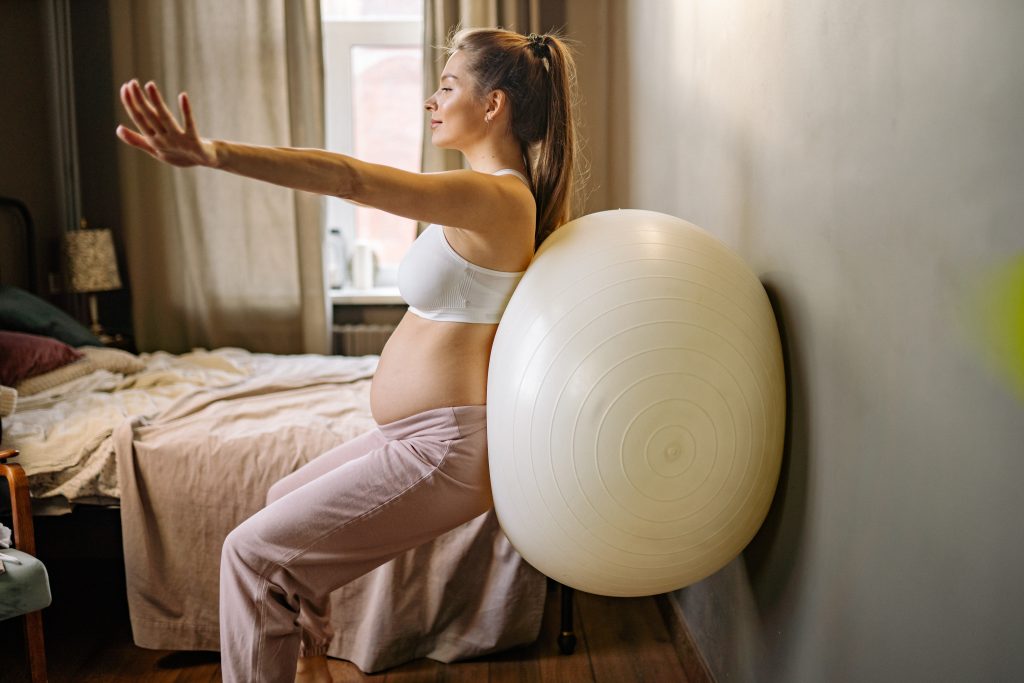Discover how incorporating pelvic tilts and other prenatal exercises into your routine can help alleviate weight-related back pain during pregnancy.
Can Pelvic Tilts and Other Prenatal Exercises Help Manage Weight-Related Back Pain?

Are you an expecting mother dealing with the annoying and sometimes downright painful backaches that often come with pregnancy? If so, you’re not alone! Weight-related back pain is a common companion for many women during this beautiful but challenging time. But fear not, my mama-to-be friends, because there’s hope! In this article, we’ll dive into the world of prenatal exercises and explore how they can be your secret weapon in managing weight-related back pain.
Understanding Weight-Related Back Pain in Pregnancy
Before we jump into the incredible benefits of prenatal exercises, let’s take a moment to understand the enemy we’re up against—weight-related back pain. Pregnancy changes your body in miraculous ways, but it also puts a lot of strain on your back. As your belly grows and your weight increases, your spine and surrounding muscles have to work extra hard to keep you upright and balanced. This extra burden can lead to discomfort and, in some cases, debilitating pain. But don’t worry, because we’re here to help!
The Anatomy of Pregnancy-Related Back Pain
Let’s break it down—what exactly happens to our poor backs during pregnancy? Well, as your baby bump grows, your weight distribution changes. This shift in gravity puts pressure on your lower back, causing muscle imbalances, strain, and, you guessed it, pain. Additionally, the ligaments supporting your spine become more relaxed due to hormonal changes, adding to the discomfort.
But that’s not all. Pregnancy-related back pain can also be influenced by the position of your baby. As your little one grows, they may settle into a position that puts additional pressure on your back. This can further contribute to the aches and pains you may be experiencing.
Furthermore, the expansion of your uterus during pregnancy can also impact your back health. As your uterus grows, it pushes against your abdominal muscles, causing them to stretch and weaken. This can lead to poor posture and increased strain on your back, making you more susceptible to pain.
The Impact of Weight Gain on Back Health During Pregnancy
Weight gain is a natural and necessary part of pregnancy, but it can take a toll on your back. The gradual increase in body mass can strain your joints and muscles, exacerbating any existing back issues. The added weight puts extra pressure on your spine, making it work harder to support your growing body.
However, it’s important to note that not all weight gain is created equal. Gaining weight in a healthy and controlled manner, under the guidance of your healthcare provider, can minimize the impact on your back. It’s essential to maintain a balanced diet and engage in regular physical activity to support your overall health and reduce the strain on your back.
Additionally, the distribution of weight gain can also play a role in back pain. If the majority of your weight gain is concentrated in your belly, it can put more stress on your back. However, if you gain weight evenly throughout your body, the load is distributed more evenly, potentially reducing the strain on your back.
Remember, every pregnancy is unique, and what works for one person may not work for another. It’s crucial to listen to your body, communicate with your healthcare provider, and explore various strategies to manage and alleviate weight-related back pain during pregnancy.
The Role of Prenatal Exercises in Alleviating Back Pain
Now that we understand the problem, let’s move on to the solution—prenatal exercises! These exercises are specifically designed to support your changing body and improve your overall well-being during pregnancy. Not only do they help manage weight-related back pain, but they also offer a myriad of other benefits for both you and your growing baby.
During pregnancy, your body goes through numerous changes, both internally and externally. These changes can often lead to discomfort and pain, especially in the lower back area. However, with the right exercises, you can effectively alleviate this pain and improve your quality of life.
The Importance of Physical Activity During Pregnancy
Physical activity during pregnancy is like a magic potion—it does wonders for your body and mind. Regular exercise helps improve blood circulation, boost your energy levels, enhance your mood, and strengthen your muscles. It also prepares your body for the challenges of labor and postpartum recovery. So, let’s get moving!
Engaging in physical activity during pregnancy not only benefits you but also your growing baby. Research has shown that exercise during pregnancy can lead to a healthier birth weight for the baby, improved brain development, and a reduced risk of gestational diabetes.
How Prenatal Exercises Contribute to Back Health
By targeting the muscles that support your back, prenatal exercises can alleviate pain and discomfort. These exercises strengthen your core, improve posture, and increase the flexibility of your spine. Plus, they release those feel-good endorphins, making you feel like a pregnancy superhero!
One of the key muscles that prenatal exercises focus on is the transverse abdominis. This deep muscle plays a crucial role in stabilizing the spine and providing support to the lower back. By strengthening this muscle, you can significantly reduce the strain on your back and alleviate pain.
In addition to strengthening the core muscles, prenatal exercises also help improve posture. As your baby grows, your center of gravity shifts, causing your posture to change. This change can put extra pressure on your back, leading to pain and discomfort. However, with regular exercise, you can maintain proper alignment and reduce the strain on your back.
Furthermore, prenatal exercises increase the flexibility of your spine, allowing it to adapt to the changes happening in your body. This increased flexibility not only helps alleviate back pain but also improves your overall range of motion, making daily activities more comfortable and enjoyable.
It’s important to note that not all exercises are suitable for pregnant women. It’s crucial to consult with your healthcare provider or a qualified prenatal fitness instructor before starting any exercise program. They can guide you on the best exercises to alleviate back pain while ensuring the safety of both you and your baby.
In conclusion, prenatal exercises play a vital role in alleviating back pain during pregnancy. They strengthen the muscles that support your back, improve posture, increase spinal flexibility, and provide a range of other benefits for both you and your baby. So, lace up your sneakers, put on some comfortable workout clothes, and get ready to embrace the wonders of prenatal exercise!
An In-depth Look at Pelvic Tilts
Now, let’s shine a spotlight on our superstar exercise—pelvic tilts! Pelvic tilts are gentle yet highly effective movements that can work wonders for your back during pregnancy.
During pregnancy, the body goes through numerous changes, and the lower back often bears the brunt of these changes. As the baby grows, the center of gravity shifts, putting additional strain on the lower back. This can lead to discomfort, pain, and even postural imbalances. That’s where pelvic tilts come in!
The Benefits of Pelvic Tilts for Pregnant Women
Pelvic tilts help strengthen your abdominal muscles and stretch your lower back, providing much-needed relief from pain and tension. These simple movements also improve your posture and promote proper alignment of your pelvis. It’s like giving your back a relaxing massage!
By engaging the abdominal muscles, pelvic tilts help to stabilize the pelvis and reduce the strain on the lower back. This not only alleviates discomfort but also helps to prevent the development of more serious conditions such as sciatica or pelvic girdle pain.
Additionally, pelvic tilts can improve circulation in the pelvic area, which is crucial during pregnancy. Proper blood flow helps nourish the growing baby and supports the overall health of the mother.
How to Perform Pelvic Tilts Safely and Effectively
Performing pelvic tilts is as easy as pie—a really beneficial pie! Here’s how it’s done: Lie on your back with your knees bent and feet flat on the floor. Gently tilt your pelvis by pressing your lower back against the floor and then release. Repeat this motion, focusing on engaging your abdominal muscles. Start with a few repetitions and gradually increase as your back becomes stronger. Remember, moderation is key!
It’s important to note that pelvic tilts should be performed with caution and under the guidance of a healthcare professional, especially during pregnancy. Each woman’s body is unique, and what works for one may not work for another. Consulting with a healthcare provider ensures that the exercise is safe and tailored to individual needs.
For added comfort and support during pelvic tilts, consider using a yoga mat or a cushioned surface. This can help cushion the spine and provide a more comfortable experience.
Remember, consistency is key when it comes to reaping the benefits of pelvic tilts. Incorporate them into your daily routine, and you’ll soon notice improvements in your back pain, posture, and overall well-being.
Other Beneficial Prenatal Exercises for Back Pain
Pelvic tilts are fantastic, but variety is the spice of life, even when it comes to exercises. Here are a few more fun and effective options to add to your prenatal exercise routine:
Yoga and Pilates for Pregnancy-Related Back Pain
Yoga and Pilates are like magic potions for your well-being. These gentle yet challenging practices improve your strength, flexibility, and balance. Specifically tailored for pregnancy, they target your core muscles and promote relaxation. Plus, who doesn’t want to feel zen while floating like a graceful swan?
Strength Training and Cardiovascular Exercises for Pregnant Women
Strength training and cardiovascular exercises, when done safely and with proper guidance, are excellent ways to maintain overall fitness during pregnancy. These activities not only keep you strong and agile but also provide a healthy outlet for any pent-up pregnancy frustrations. Channel your inner wonder woman!
Precautions and Guidelines for Prenatal Exercises
While prenatal exercises are generally safe and beneficial, there are a few precautions and guidelines to keep in mind for a worry-free experience.

When to Avoid Certain Prenatal Exercises
As much as we cherish exercise, there are instances when you should put your workout on hold. These include high-risk pregnancies, specific medical conditions, and any exercise that causes pain or discomfort. Always consult your healthcare provider before starting or modifying any exercise program.
Tips for Safe and Effective Exercise During Pregnancy
To ensure a happy and healthy exercise journey, follow these simple guidelines: stay hydrated, wear comfortable clothing, warm-up thoroughly before each workout, listen to your body’s cues, and don’t overexert yourself. Your health and well-being always come first!
So, dear mothers-to-be, take charge of your back and bid farewell to weight-related back pain with the power of exercise. Incorporate pelvic tilts and other prenatal exercises into your routine, and soon you’ll be dancing through your pregnancy with a smile on your face and a spring in your step. Remember, a fit mama is a happy mama!



